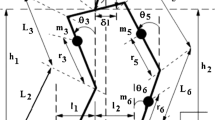Abstract
Humanoid robots generally have the problem of losing balance and falling down when voltage of joints decreases, which results in damage of hardware devices like mechanical structure and circuit control board. In order to deal with this problem, we simplified the stable control model of a humanoid robot into a quadruple inverted pendulum, corresponding to the robot’s shanks, thighs, torso, and arms, and regarded the bipedal locomotion in the horizontal direction as the movement of cart foundation of the inverted pendulum. We analyzed differential equations of motion and conditions of the complete stability of the quadruple inverted pendulum, imitated and performed falling down of human with protective postures. Combining with kinematics and physical constraints, we implemented a dynamic multi objective optimization algorithm to optimize the angles and angular speed of each joints. This helped the deceleration of the robot’s falling down process and reduced the ground impact force that achieved minimum momentum consumption and immediate stabilization after robot falling down, which can mitigate the damage of the robot’s hardware devices. We did simulation experiments and verified the effectiveness of the method.








Similar content being viewed by others
References
Fujiwara K, Kajita S, Harada K, Kaneko K, Morisawa M, Kanehiro F, Nakaoka S, Hirukawa H (2007) An optimal planning of falling motions of a humanoid robot. In: 2007 IEEE/RSJ International Conference on Intelligent Robots and Systems, IEEE, pp 456–462
Kudoh S, Komura T, Ikeuchi K (2006) Stepping motion for a human-like character to maintain balance against large perturbations. In: Proceedings 2006 IEEE International Conference on Robotics and Automation, 2006. ICRA 2006., IEEE, pp 2661–2666
Stephens B (2007) Integral control of humanoid balance. In: 2007 IEEE/RSJ International Conference on Intelligent Robots and Systems, IEEE, pp 4020–4027
Yamane K, Hodgins J (2009) Simultaneous tracking and balancing of humanoid robots for imitating human motion capture data. In: 2009 IEEE/RSJ International Conference on Intelligent Robots and Systems, IEEE, pp 2510–2517
Lee J-H, et al. (2012) Full-body imitation of human motions with kinect and heterogeneous kinematic structure of humanoid robot. In: 2012 IEEE/SICE International Symposium on System Integration (SII), IEEE, pp 93–98
Ge SS, Li Z, Yang H (2011) Data driven adaptive predictive control for holonomic constrained under-actuated biped robots. IEEE Trans Contr Syst Technol 20(3):787–795
Li Z, Ge SS (2013) Adaptive robust controls of biped robots. IET Control Theory & Applications 7(2):161–175
Ogrinc M, Gams A, Petrič T, Sugimoto N, Ude A, Morimoto J, et al. (2013) Motion capture and reinforcement learning of dynamically stable humanoid movement primitives. In: 2013 IEEE International Conference on Robotics and Automation, IEEE, pp 5284–5290
Gams A, Van den Kieboom J, Dzeladini F, Ude A, Ijspeert AJ (2015) Real-time full body motion imitation on the coman humanoid robot. Robotica 33(5):1049–1061
Nierhoff T, Hirche S, Takano W, Nakamura Y (2014) Full body motion adaption based on task-space distance meshes. In: 2014 IEEE International Conference on Robotics and Automation (ICRA), IEEE, pp 1865–1870
Hu D, Chen M, Wang T, Chang J, Yin G, Yu Y, Zhang Y (2018) Recommending similar bug reports: A novel approach using document embedding model. In: 2018 25Th Asia-pacific Software Engineering Conference (APSEC), IEEE, pp 725–726
Hatzakis I, Wallace D (2006) Dynamic multi-objective optimization with evolutionary algorithms: A forward-looking approach. In: Proceedings of the 8th Annual Conference on Genetic and Evolutionary Computation, ACM, pp 1201–1208
Hu L, Zhou C, Sun Z (2008) Estimating biped gait using spline-based probability distribution function with q-learning. IEEE Trans Ind Electron 55(3):1444–1452
Khoukhi A (2009) Data-driven multi-stage motion planning of parallel kinematic machines. IEEE Trans Contr Syst Technol 18(6):1381–1389
Saputra AA, Botzheim J, Sulistijono IA, Kubota N (2015) Biologically inspired control system for 3-d locomotion of a humanoid biped robot. IEEE Trans Syst Man Cybern Syst 46(7):898–911
Kelaiaia R, Company O, Zaatri A (2012) Multiobjective optimization of a linear delta parallel robot. Mech Mach Theory 50:159–178
Bidgoly HJ, Parsa A, Yazdanpanah MJ, Ahmadabadi MN (2017) Benefiting from kinematic redundancy alongside mono-and biarticular parallel compliances for energy efficiency in cyclic tasks. IEEE Trans Robot 33 (5):1088–1102
Hamelin P, Bigras P, Beaudry J, Richard P-L, Blain M (2014) Multiobjective optimization of an observer-based controller: Theory and experiments on an underwater grinding robot. IEEE Trans Contr Syst Technol 22(5):1875–1882
Villarreal-Cervantes MG, Cruz-Villar CA, Alvarez-Gallegos J, Portilla-Flores EA (2012) Robust structure-control design approach for mechatronic systems. IEEE/ASME Trans Mech 18(5):1592–1601
Deb K, Pratap A, Agarwal S, Meyarivan TAMT (2002) A fast and elitist multiobjective genetic algorithm: Nsga-ii. IEEE Trans Evol Comput 6(2):182–197
Kim S, Kim CH, Park JH (2006) Human-like arm motion generation for humanoid robots using motion capture database. In: 2006 IEEE/RSJ International conference on intelligent robots and systems, IEEE, pp 3486–3491
Li H, Zhihong M, Jiayin W (2002) Variable universe adaptive fuzzy control on the quadruple inverted pendulum. Science in China Series E:, Technological Sciences 45(2):213–224
Niku SB (2001) Introduction to robotics. Prentice Hall Professional Technical Reference
Acknowledgements
All authors declare that: (i) no support, financial or otherwise, has been received from any organization that may have an interest in the submitted work; and (ii) there are no other relationships or activities that could appear to have influenced the submitted work.
Author information
Authors and Affiliations
Corresponding author
Additional information
Publisher’s note
Springer Nature remains neutral with regard to jurisdictional claims in published maps and institutional affiliations.
This article belongs to the Topical Collection: Special Issue on Future Networking Applications Plethora for Smart Cities
Guest Editors: Mohamed Elhoseny, Xiaohui Yuan, and Saru Kumari
Rights and permissions
About this article
Cite this article
Chang, L., Piao, S., Leng, X. et al. Study on falling backward of humanoid robot based on dynamic multi objective optimization. Peer-to-Peer Netw. Appl. 13, 1236–1247 (2020). https://doi.org/10.1007/s12083-019-00858-5
Received:
Accepted:
Published:
Issue Date:
DOI: https://doi.org/10.1007/s12083-019-00858-5




